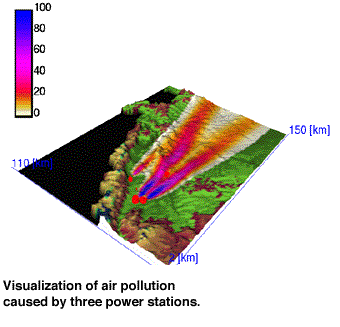Modelling of the Environmental Impact of Main Airborne Pollutants Producers
by Frantisek Hrdlicka and Pavel Slavík
The vast part of electricity produced in the Czech Republic is produced in power stations where as a fuel the brown coal is used. This type of coal contains elements (like sulphur dioxide etc.) that have a very negative impact on the environment. During smog alert situations it is necessary to reduce emissions from power stations to an acceptable level either by lowering output of power stations in the region or by usage of high quality coal in some power stations.
The question which power stations should be regulated is a very critical one.
Such a decision is based on the data from the network of monitoring stations that monitor pollution and from data obtained from the national meteorological institute.
 The
problem is that these data are not interpreted in a wide context what leads
to situations when it is impossible to determine the power station that
has the largest contribution to the level of pollution in the critical
area. The solution to this problem is to develop a mathematical model that
can simulate the distribution of pollutants in a given region under certain
meteorological conditions. In such a way it is possible to determine the
contribution to pollution in the investigated (critical) area for each
single power station. Thus it will be possible to determine the power station
with the largest impact and the corresponding measures can be taken (either
to lower output or to switch to higher quality coal). In such a context
it is possible to optimize the output lowering process as this process
has besides ecological criteria also economic ones. Therefore a software
system has been developed that describes the emission distribution in the
atmosphere. The mathematical model used is based on the statistical theory
of diffusion namely Briggs and Giffords theory of diffusion. This
theory belongs to the class of theories called Gaussian models as the distribution
of gas concentration is controlled by the properly modified Gaussian distribution.
The
problem is that these data are not interpreted in a wide context what leads
to situations when it is impossible to determine the power station that
has the largest contribution to the level of pollution in the critical
area. The solution to this problem is to develop a mathematical model that
can simulate the distribution of pollutants in a given region under certain
meteorological conditions. In such a way it is possible to determine the
contribution to pollution in the investigated (critical) area for each
single power station. Thus it will be possible to determine the power station
with the largest impact and the corresponding measures can be taken (either
to lower output or to switch to higher quality coal). In such a context
it is possible to optimize the output lowering process as this process
has besides ecological criteria also economic ones. Therefore a software
system has been developed that describes the emission distribution in the
atmosphere. The mathematical model used is based on the statistical theory
of diffusion namely Briggs and Giffords theory of diffusion. This
theory belongs to the class of theories called Gaussian models as the distribution
of gas concentration is controlled by the properly modified Gaussian distribution.
The model discussed has been implemented by means of the IRIS Explorer system on Silicon Graphics computers. An important problem to be solved was the userfriendliness of the system. The results of simulation have a form of a map with colour representation of the pollution level. The input has also graphical form where by means of direct manipulation techniques the input values are set. This concerns for example the settings of parameters for each single power station or setting the meteorological conditions in the region. It is also possible to click on any location on the map and the information about the current level of pollution together with share of each single power station in a graphical form is displayed. Moreover it is possible to set parameters that define an animation sequence that represents dynamical change of some parameters of the process investigated.
The model has been evaluated by means of comparison of simulated data and a real data. The real data were influenced by other sources of pollution than power stations investigated what had impact on the match between the model and reality. Nevertheless there was a good match from the point of influence of each single power station on the level of pollution in the region investigated.
The system developed is a pilot system for the given application. There is a lot of potential for further development. Future work could lead to the development of a model where the data obtained from the network of monitoring stations can be interpreted by means of information obtained from the model developed. It could be possible to employ methods of artificial intelligence that will support learning process of the system that could help to eliminate the influence of local sources of pollution. The model developed could be also used for simulation of gas distribution during ecological disasters like accidents in chemical plants or in nuclear power stations. It could be possible to model and evaluate various measures that could be taken in the case of disaster.
Please contact:
Frantisek Hrdlicka - Department of Thermal and Nuclear Power Plants,
Czech Technical University, Prague
Tel: +420 2 2435 2535
E-mail: hrdlicka@fsid.cvut.cz
